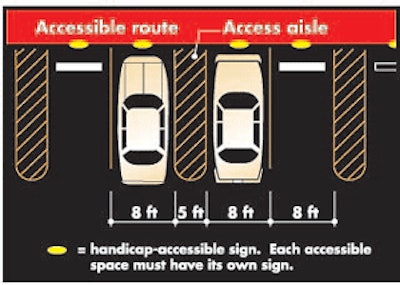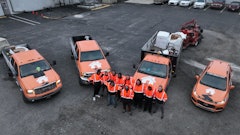
The difference between working with Americans with Disabilities Act (ADA) regulations today and working with ADA regulations when the Act was signed into law in 1990 is primarily one of recognition. Contractors initially had to explain the ADA guidelines to their customers, who then had to "buy in" to the regulations before any alterations were made.
Today most property managers and owners know the guidelines exist, even if they don't know what they include. So it's become the job - and an opportunity - for contractors to educate their customers about what they need to do to bring their property into compliance.
Not necessarily as easy as it sounds, partly because of the bureaucratic mess the government has made in developing, implementing, publishing, and enforcing the guidelines.
Here's how it works: According to an ADA Access Board spokesman, the Access Board develops ADA guidelines, which are just that: a set of recommended specs or practices the Board thinks should be followed. Once developed, those guidelines are used as the basis for "standards," which are applied by the Department of Justice (DOJ) or the Department of Transportation (DOT). It is these "standards" that must be applied and followed when restriping or doing most parking lot related construction work.
But just to complicate things a little more, the guidelines and standards are not necessarily the same. When initially put into effect the DOJ and DOT simply adopted the ADA guidelines as a whole, making the guidelines the standards. But since then the DOJ has used the guidelines more as guides and has modified them, with input, to suit what it sees as the most important concerns.
Further complicating the issue is that while 26 states have taken the Access Board guidelines and incorporated them into state statute, many states (including some of the 26) have altered the guidelines making them more restrictive. Florida, for instance, requires that "Each [accessible] parking space must be prominently outlined with blue paint, and must be repainted when necessary, to be clearly distinguishable as a parking space designated for persons who have disabilities ?" among other changes. And Rockville, MD, requires one of every four accessible spaces - as opposed to one in every eight - be van accessible.
So the first thing for contractors (and their customers) to realize is that the federal ADA regulations establish only minimum specifications for accessibility. States and localities can go beyond these federal requirements, so it's essential to learn the requirements for the states and localities in which you work.
What is barrier removal?
The ADA requires public accommodations to remove "architectural barriers" in existing facilities when "readily achievable" to bring properties into compliance.
According to the DOJ ADA Standards for Accessible Design, "Because removing barriers to accessible parking generally involves relatively low cost, it may be readily achievable for many public accommodations."
The DOJ says examples of barrier removal related to accessible parking may include "restriping a section or sections of a parking lot to provide accessible parking spaces with designated access aisles, installing signs that designate accessible parking spaces, providing an accessible route from the accessible parking spaces to the building entrance, and providing a marked crossing where the accessible route crosses a vehicular way."
The importance of "readily achievable"
One of the determining factors in many ADA compliance issues is whether or not the change to bring the property into compliance is what the DOJ and ADA Access Board consider "readily achievable."
"Readily achievable" means "easily accomplishable and able to be carried out without much difficulty or expense." Often readily achievable is determined on a case-by-case basis, and among the factors taken into account are:
- The nature and cost of the action
- The overall financial resources of the site or sites involved; the number of persons employed at the site; the effect on expenses and resources; legitimate safety requirements necessary for safe operation, including crime prevention measures; or any other impact of the action on the operation of the site
- The geographic separateness, and the administrative or fiscal relationship of the site or sites in question to any parent corporation or entity
- If applicable, the overall financial resources of any parent corporation or entity; the overall size of the parent corporation or entity with respect to the number of its employees; the number, type, and location of its facilities; and
- If applicable, the type of operation or operations of any parent corporation or entity, including the composition, structure, and functions of the workforce of the parent corporation or entity.
Any newly constructed public facility must provide accessible parking spaces including van accessible parking spaces. If you repave or otherwise alter the parking lot at existing facilities, you must add as many accessible parking spaces, including van spaces, as needed to comply with current mandates. If you restripe the parking area, you must restripe to provide the correct number of accessible parking spaces, including van accessible parking.
Over the years the Dept. of Justice has determined that in general parking lot striping or restriping, installation of accessible signs, and construction of curb ramps are generally not an impediment to "readily achievable" improvements. In other words, unless there's some other reason, bringing parking lots and surrounding sidewalks into compliance with the ADA is something property managers must do each time they restripe.
In some cases existing, physical site constraints might make it "technically infeasible" to comply fully with the Standards. But the Standards make it clear that such a "technically infeasible" condition usually exists only in a portion of a parking lot, and other suitable locations for accessible parking spaces are often available."
Accessible parking spaces
Every parking lot must have at least one accessible parking space that meets ADA requirements. If the parking lot has only one accessible parking space that space must be van-accessible. The chart on page 22 outlines the specific requirements for the number of accessible spaces required.
All accessible spaces need to be placed on level ground and as close to an accessible entrance as possible. If the parking spaces closest to an accessible entrance aren't usable - if the pavement there is too sloped, for example - accessible spaces can be located at the nearest area in compliance.
The accessible space (and its access aisle) must be on level pavement with a maximum slope of 1:50 (a change in the vertical height of no more than one unit (inch) over a distance of 50 units (inches). In addition, the access aisle must have a firm, stable, and non-slip surface.
Accessible parking spaces must be 96 inches wide and must be immediately adjacent to a 60-inch access aisle. Two accessible parking spaces can share an access aisle, and the boundaries and ends of the access aisle must be clearly marked. The access aisle must be striped or marked in some manner to discourage drivers from parking there. Ends of access aisles can be squared or rounded.
While the ADA does not require pavement stencils indicating a space is accessible, it does require a sign located at the front of the parking space indicating the space is accessible. The sign must include the international symbol of accessibility and must be placed at a height high enough that it is not blocked by a parked vehicle.
If the front of the parking space is adjacent to the accessible route then wheel stops must be installed to prevent the front of parked vehicles to extend into the access route, reducing its width to less than 36 inches.
How are van accessible spaces different?
Van-accessible parking spaces must follow the requirements for car-accessible spaces with only a few differences. If a parking lot has only one accessible space it must be van-accessible.
Van-accessible spaces must feature a 96-inch-wide parking space plus a 96-inch-wide access aisle immediately adjacent to the parking space on the passenger side of the vehicle. Just as with car-accessible spaces, the van access aisle must be marked in some way - cross-hatching is most common?to discourage parking.
One significant change in an upcoming but still pending revision of ADAAG since the guidelines initially went into effect is that one in six accessible spaces must be van-accessible spaces (initial guidelines required only one in eight be van accessible). So for every six accessible spaces - or every fraction of six accessible spaces - one space must be van accessible. This is already being adopted in some states where applicable in certain International Building Code documents. So if a parking lot contains nine parking spaces, two must be van accessible.
Because the space is intended for vans, the entire driving route to the space, the space itself, and the driving route from the space to the parking lot exit must have a vertical clearance of at least 98 inches. The sign at the front of the parking stall must also have the words "van accessible" below the international symbol of accessibility.
Accessible routes
The access aisle must be part of an accessible route to a building entrance. The access route must not be obstructed by any objects such as a curb, outdoor furniture, signs, or shrubbery, and vehicles that might extend into the accessible route.
Access routes must not have curbs or stairs, must be at least three feet wide, and must have a firm, stable, slip-resistant surface. Slope must not be greater than 1:12 in the direction of travel.
Where should accessible parking spaces be located?
Accessible parking spaces, including van accessible spaces, must be located on the shortest accessible route from adjacent parking to the accessible entrance of a building. If possible the accessible route should not pass behind parked vehicles. Accessible parking spaces and the required accessible route should be located where people with disabilities do not have to cross a traffic lane.
Accessible parking spaces and required accessible routes should be located where individuals with disabilities do not have to cross a vehicular lane.
DOJ recommends that "when parking cannot be located immediately adjacent to a building and the accessible route must cross a vehicular route, then it is recommended that a marked crossing must be used where the accessible route crosses the vehicular route."
At properties such as shopping malls that have multiple accessible entrances with adjacent parking spaces, the accessible parking spaces must be dispersed. But when parking spaces are located in a parking garage, the van accessible parking spaces can be grouped on one floor, particularly if inadequate vertical clearance exists in other sections of the parking garage.
Ramps & curb ramps
There is a difference between ramps and curbs ramps. Ramps are "a walking surface that has a running slope steeper than 1:12." This is a relaxing of the prior guidelines.
Under the new guidelines ramps on accessible routes with a maximum rise of 3 inches can have a slope steeper than 1:10 but not steeper than 1:8. A ramp that rises 6 inches can have a slope steeper than 1:12 but not steeper than 1:10. Ramps must have edge protection, such as a curb, that prevents a 4-inch-diameter ball from rolling off them.
A curb ramp is "a short ramp cutting through a curb or built up to it." Curb ramps (often referred to as curb cuts) must be installed wherever an accessible route crosses a curb. Curb ramps must be a minimum of 36 inches wide, exclusive of flared sides, and flares must not be steeper than 1:10.
In some cases curb ramps can be built up. According to the DOJ, these built-up curb ramps must be located so they do not project into vehicular traffic lanes; the revised ADAAG adds that built up curb ramps can't project into parking spaces or parking access aisles.
If built-up curb ramps are located at marked crossings, the entire curb ramp must be contained within the markings (excluding flared sides).
For any specific questions concerning the ADA and its guidelines contact the Department of Justice Accessibility Rights Division at 800-514-0301.
Access Aisle. The area immediately adjacent to an accessible parking space. Access aisles must be marked in some way to discourage parking in them. Cross hatching is generally used. Access aisles must be part of an accessible route from the parking lot to the building entrance.
Access Route. The travel approach from the parking lot to the entrance. Accessible routes must be at least 36 inches wide, and surfaces must have a slope no greater than 1:20. If the slope is greater than 1:20 a curb ramp must be constructed.
Cross Slope. The slope that is perpendicular to the direction of travel (see running slope).
Curb Ramp. A short ramp cutting through a curb or built up to it.
Detectable Warning. A standardized surface feature built in or applied to walking surfaces or other elements to warn of hazards on a circulation path.
Marked Crossing. A crosswalk or other identified path intended for pedestrian use in crossing a vehicular way.
Ramp. A walking surface that has a running slope steeper than 1:20.
Running Slope. The slope that is parallel to the direction of travel (see cross slope).
Vehicular Way. A route provided for vehicular traffic, such as in a street, driveway, or parking facility.
"Readily achievable" changes include...
The Department of Justice's regulation lists 21 examples of modifications that may be "readily achievable." Examples of barrier removal related to accessible parking may include restriping a section or sections of a parking lot to provide accessible parking spaces with designated access aisles, installing signs that designate accessible parking spaces, providing an accessible route from the accessible parking spaces to the building entrance, providing a marked crossing where the accessible route crosses a vehicular way, installing ramps, and making curb cuts.
The DOJ notes that "Removing barriers by ramping a curb?or designating an accessible parking space is often essential to ensure equal opportunities for people with disabilities. Because removing these and other common barriers can be simple and inexpensive in some cases and difficult and costly in others, the regulations for the ADA provide a flexible approach to compliance."
However, parking lot striping or restriping and curb cuts for ramps has generally been considered by DOJ as compliance steps that are "readily achievable."
Detectable Warnings Still Required
According to Jon Julnes, president of ADA Vanguard, the DOJ says detectable warnings are required on all curb ramps intended for public use.
But detectable warnings are one of the most misunderstood aspects of the ADA, and for good reason. A detectable warning is defined as "a standardized surface feature built in or applied to walking surfaces or other elements to warn of hazards on a circulation path." Detectable warnings are further defined by DOJ, ADAAG, The Federal Access Board and DOT/FHWA as "only truncated domes." All other shapes and or textures are "out of compliance" with the federal design standards.
In its initial format, the ADAAG recommended installation of detectable warnings; the DOJ agreed, as did later the new International Building Code (via ANSI standards). Due to a suspension of the mandate to allow for further study in 1996, from 1996 - 2001 use of detectable warnings became optional, but the revised ADAAG drops its recommendation for detectable warnings again, making no comment about them at all.
However, both the DOJ (which enforces ADAAG) and the IBC (where applicable ANSI standards have been adopted), include detectable warnings in their regulations. But Julnes says recent decisions have clarified their use - and detectable warnings are required on both public and private properties until otherwise determined by DOJ.
"Few other items have been singled out in the Federal Register in CFRs (Code of Federal Regulations) more than detectable warnings," Julnes says. "They're trying very hard to make this point clear."
According to a more recent Federal Register (October 30, 2006), "The Department [of Justice] is also adopting language that would continue in effect the current requirements of ADAAG concerning detectable warnings at curb ramps. Detectable warnings in curb ramps have long been required by ADAAG and DOT and DOJ regulatory standards that have long been, and remain, in effect."
"The Department, along with an overwhelming majority of Access Board members, believes that detectable warnings are a very useful design feature that makes the built environment safer and more accessible for persons with impaired vision," according to the Federal Register. "The Department will therefore maintain the status quo with respect to detectable warnings in this rule. Doing so will not add any burdens for regulated parties or create any new or increased costs for them: regulated parties will just continue complying with precisely the same requirements that have applied to them ?since 1991."
And in ADA modifications adopted by the DOT in March 2007, the DOT determined that "A curb ramp shall have a detectable warning...The detectable warning shall extend the full width of the curb ramp (exclusive of flared sides) and shall extend either the full depth of the curb ramp or 24 inches deep minimum measured from the back of the curb on the ramp's surface."





















